
A Guide to the Amphibians
and Reptiles of California
Andy Cat's Un-Excellent Adventure

Andy before his misadventure...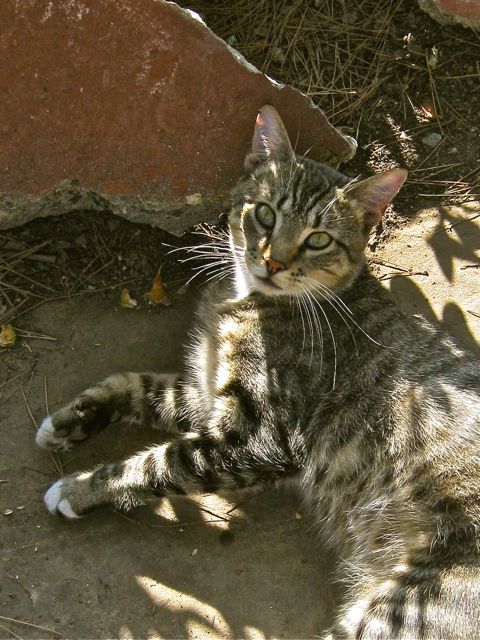 |
I'm very pleased to report that Andy cat, the formerly feral tabby cat someone dumped up here on the edge of Angeles National Forest, is doing incredibly well after being struck by a rattlesnake sometime on Monday afternoon (2 April 2012). This was a costly cat misadventure and we figure Andy has definitely used up 7 or 8 of his 9 lives! Andy has been making great progress in becoming the latest inadvertent member of our family. From a starved, wary cat that neighbors called "Raggedy Andy," who had never been picked up in his life, to a loving, well-fed, talkative house tabby is progress indeed! When I returned home on 2 April just after sunset I found Andy on his customary patio chair under the eave near our door. I could tell something was wrong at a glance. Andy was curled up and made a weak, bird-like squeak to get my attention. He looked very ill with a seriously swollen right shoulder, leg and paw. I carried him inside and discovered that he could not walk on his right paw. When I examined him closely and saw the characteristic blood seeping from his paw tip (not clotting) and noted all the swelling, I knew he'd had an unfortunate encounter with a Southern Pacific Rattlesnake. They are very common all around our foothill home, of course. Usually, cats, including Andy, are smart enough to leave them alone... but sometimes accidents happen, particularly with smaller snakes. What to do post-envenomation is controversial. There are numerous recommendations regarding treatment of cats with and without antivenin, steroids, and/or plasma transfusions; which pain medications to administer, and so forth. Horror stories abound. Andy's right paw looked quite bloated and gruesome as we arrived at the Emergency Veterinary Clinic where Andy received antivenin, along with antibiotics, anti-inflammatory and pain medications. Near as I can tell, Andy was either unlucky enough to step on... or step too close... to a rattlesnake or batted at one (a really dumb idea). The fact that the fang marks were on top of his paw instead of on his pads *may* indicate he accidentally stepped too close to a concealed snake. When a cat slaps at a rattlesnake, they often get struck on the underside of the paw (in their pad) or on the side. Who knows. A day and a half later, Andy is much recovered, completely mobile, and complaining. Yes, he wants to go back outside in the sunshine and is perturbed to be stuck inside the house. We've been bringing this formerly feral cat inside at sunset, but letting him out part of the day. Domestication can be a slow process with recently neutered male cats. Andy is very affectionate, but still strongly desires to hang out on the patio outside and to climb our trees. In terms of after effects, Andy still has moderate diarrhea (expected with hemolytic venom) and some slightly bloody serum seeping from his right paw; however, the skin around the fang marks remains pink with good circulation and has not yet darkened (prior to sloughing of the site, which is very common). The swelling of his leg is down, his appetite is excellent, he's drinking water normally, and using his litter box. I declare him out of the woods. Andy's got an embarrassingly shaved neck (where blood draw occurred) and left forearm (for IV administration of medications), but his fur will grow back quicker than Rob's pocketbook will recover from the cost of the antivenin. Antivenin is $600 or more per dose and many veterinary clinics push multiple doses, plus serum transfusions... add that to in-hospital care, pain medication, etc. and the cost of treating snake bite can easily top $3,000 to $4,000 per cat (or dog or horse). We love Andy, but that's way out of budget. It is our opinion that our conservative compromise for supportive care gave Andy the best chance to survive while minimizing cost. That included being courteous, but firm, with the emergency hospital, whose staff tends to take the attitude that an animal either gets every possible treatment... or take your animal home and hope for the best. There IS a middle ground: First, run a real-time blood test to determine the condition of the animal, most critically the clotting factors. How sick is the cat (or dog, or horse?) Are they alert? Etc. Next, administer one dose of antivenin to halt the worst hemolytic toxicity of the snake's venom, along with anti-inflammatory medication (to reduce swelling, etc.) and pain medication. Keep the animal calm and comforted (preferably in the presence of a trusted owner, not alone in a cage in a noisy emergency room as we were forced to do with Andy for a few hours). Observe the victim and see how they react to the antivenin (which can have serious side-effects of its own), how the wound appears and so forth. If, after initial treatment and an hour or two, the animal is totally alert and demonstrably better, our recommendation is to take them home for recovery. We are sure we did the right thing for Andy by bringing him home Monday night, contrary to what the emergency hospital strongly recommended, He was terrified in the hospital observation cage around all the strange people and smells, and amidst the cries of other animals in pain and barking dogs. Being scared and away from us (the only humans he trusted) drove up Andy's heart and respiratory rate at a time when that sort of stress could be very dangerous. As soon as Andy was stable and had received the antivenin, we contrived to take him home. The hospital tried to keep him and also highly recommended costly plasma transfusions, which required transporting him to another emergency veterinary hospital; however, Andy appeared alert and his clotting factors, while depressed, were not ghastly... so instead of driving him to the Glendale hospital where he could get the transfusion (for thousands of dollars of additional cost), we headed home. This was a harrowing decision, made after consulting with friends and veterinary colleagues via cell phone; however, one that we had to make on the spot, for Andy's sake. As soon as we arrived home, Andy immediately used his litter box box (great sign), drank some water (also good news) and then proceeded to stand on his hind legs to look out the window at the woodrats raiding the bird feeder (clearly his predatory little mind was working fine). An hour or so later he asked for food, so we fed him a little. Andy was clearly feeling better. Nonetheless, we decided to sleep in the living room on the sofa bed so we could hear if Andy had any respiratory or other distress. Also, Andy just appreciated our proximity. He'd had quite a scare between the snake bite and the nasty veterinary "Zombies" who mishanded him and stuck mysterious needles into his body (how creepy!). Usually, we sleep in our bedroom where Miss Hiss, the other rescued cat, lives in the back part of the house... We've not yet been able to introduce the two cats to one another without threat of serious mayhem. Curse those who dump cats in coyote country and who torture cats like Miss Hiss (she's the Maine Coon cat who was clearly abused and had cigarette burn scars on her belly). We only got about 2 1/2 hours sleep in the wee hours of Tuesday before work the next day.... but Andy was worth our trouble. He was one lucky cat... this time. There is no sure guidance for an owner whose animal has been struck by a rattlesnake. Even veterinarians disagree regarding optimal treatment protocols. Every incident must take into account the amount of venom injected, time lapsed before treatment commences, the condition of the animal (size, age, species and health) along with other factors. That said, I do recommend that owners explore options and strongly consider the little-acknowledged adverse physiological consequences of leaving their animal at a hospital where the cat or dog will experience fear and stress while in extreme pain. Panic can greatly worsen the effects of snake bite. An animal's attitude can make a big difference in their chance of recovery. Sometimes the presence of a beloved human owner, or another animal companion, can pull the victim through. And, quite honestly, if Andy were destined to die from the snake bite, we greatly preferred that to happen in his own home in our comforting arms, than alone in a cold hospital cage, wondering why we had abandoned him when he needed and trusted us most. Veterinarians and staff tend to dismiss and denigrate the psychological aspects of an animal's recovery. Owners should respect and objectively evaluate veterinary advice. At the same time, do not be pressured into leaving an animal against better judgement or into paying far more for "full" treatment than is probably needed by the animal. The challenge is to provide the snake bite victim with the least intrusive and least risky supportive care that will enable the animal to recover on its own. A key aspect is keeping the patient calm and as comfortable as possible. Conversely, a critically ill, unconscious cat or dog should be left in veterinary care. In that case, an owner should obtain an accurate estimate for the cost of treatment in advance. Be sure to consider costs and weigh alternatives, in spite of the emotion and urgency of the moment. Many owners are blind-sided when they get an astronomical bill for repeated antivenin and IV medications, tragically, in some cases, after their beloved cat or dog has passed away in spite of extensive intervention. That's our report on Andy and 2 cents of advice! Feline felicities & reptilian regards, |
Andy in his carrier at the the Emergency Veterinary Clinic around 9:00pm (photo taken without flash by an iPhone). He held his painful paw up slightly, it was seeping serum and blood, and his entire paw and shoulder were swollen.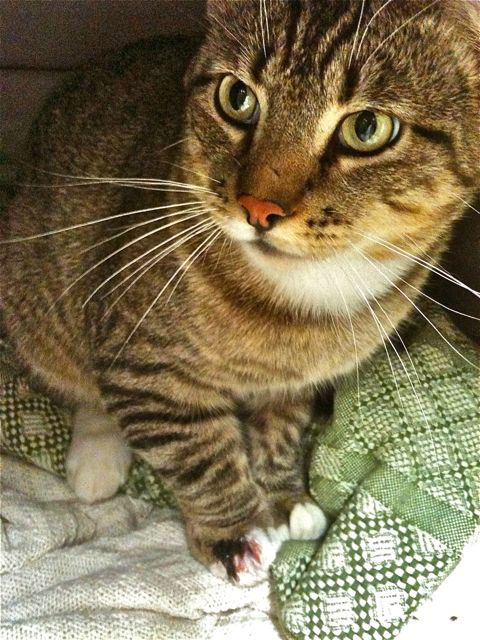 |
At the hospital, we could clearly see the fang puncture wounds on top of his right paw that remained open and seeping, even though he had probably been bitten a few hours before we found him. This is evidence of the venom preventing clotting and scab formation. Look close and one puncture can be seen in the photo below.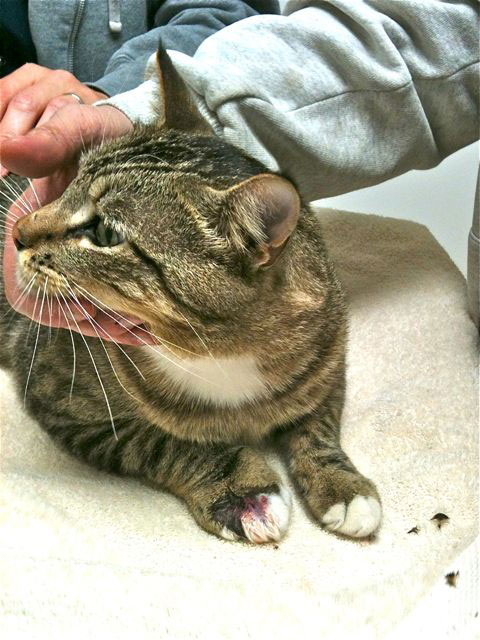 |
Andy's usually slender right paw was incredibly swollen, causing his dew claw and pads to distend. The swelling extended to the top of his shoulder. Amazingly, though the paw was quite painful, Andy continued to stand on it, though he limped when walking a few steps at the hospital.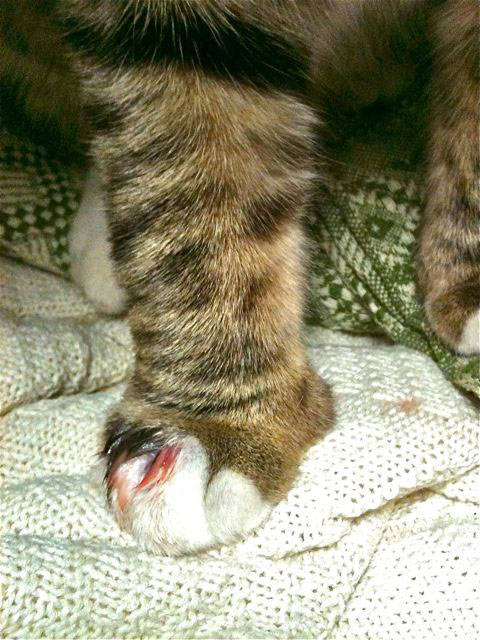 |
Andy's swollen right shoulder, leg and paw after treatment (when we brought him home just before Midnight on Monday). When I found him, his paw and leg were about a third larger than in this photo. The rattlesnake fang marks were about 3/8" apart on the top of his paw.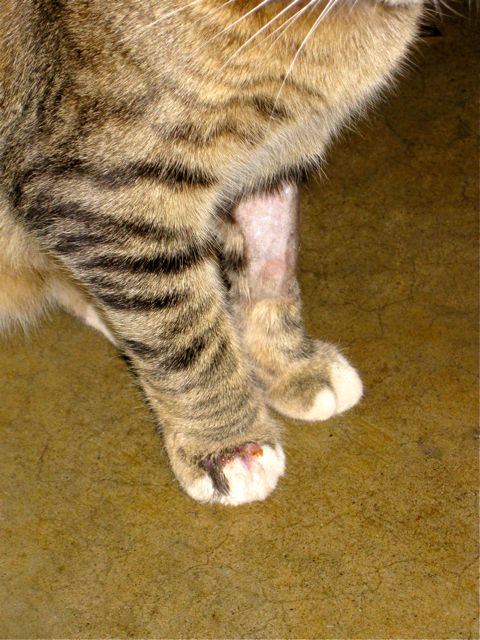 |
Andy after we brought him home on Monday near Midnight. He was obviously pleased to be back home, but still felt a bit punky.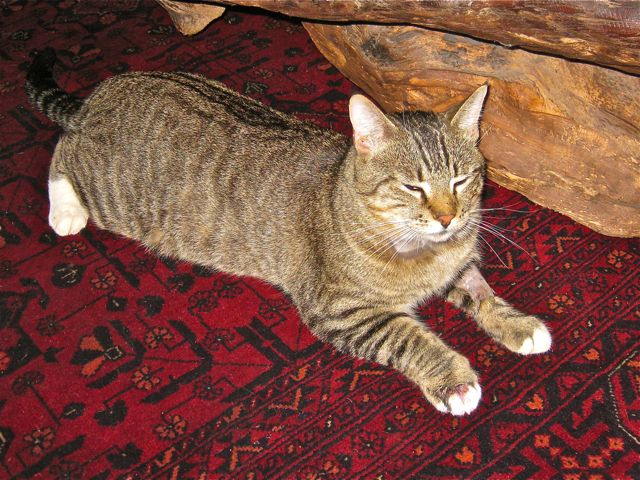 |
Andy the next morning on 3 April 2012. He was perfectly capable of getting on top of his favorite recliner, but his leg is clearly still swollen and the paw continued to seep serum. Cats are good at keeping themselves clean. Andy licked the paw a little, but was good about not irritating the wound. Grooming is actually a good sign of recovery.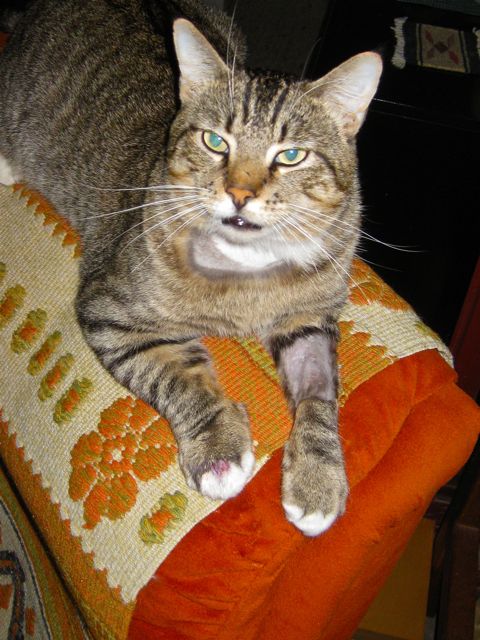 |
Andy complaining later the same morning on the dining room carpet. Through still a little swollen, the right paw is clearly closer to normal size. One lucky unlucky cat.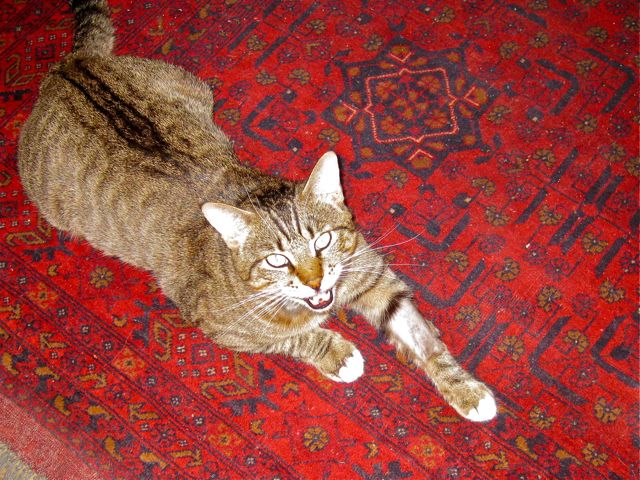 |
| 22 April 2012 Update |
No... Andy has not expired in the photo below! This is what a contented cat nap looks like 20 days after the rattlesnake bite. Andy sometimes sleeps on his back, purring and "whispering" contentedly to himself. His paw has healed completely (the top front paw in this photo), though there is no fur yet on the area around the fang punctures. Fortunately, the skin immediately around the bite did not slough at all. 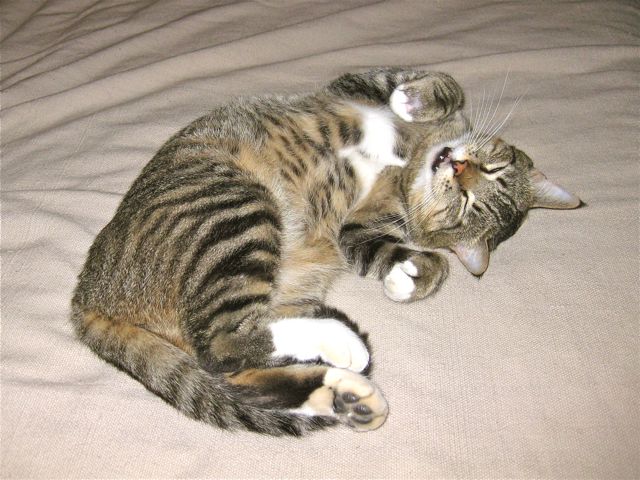 |
Return to the Top
© 2000 -